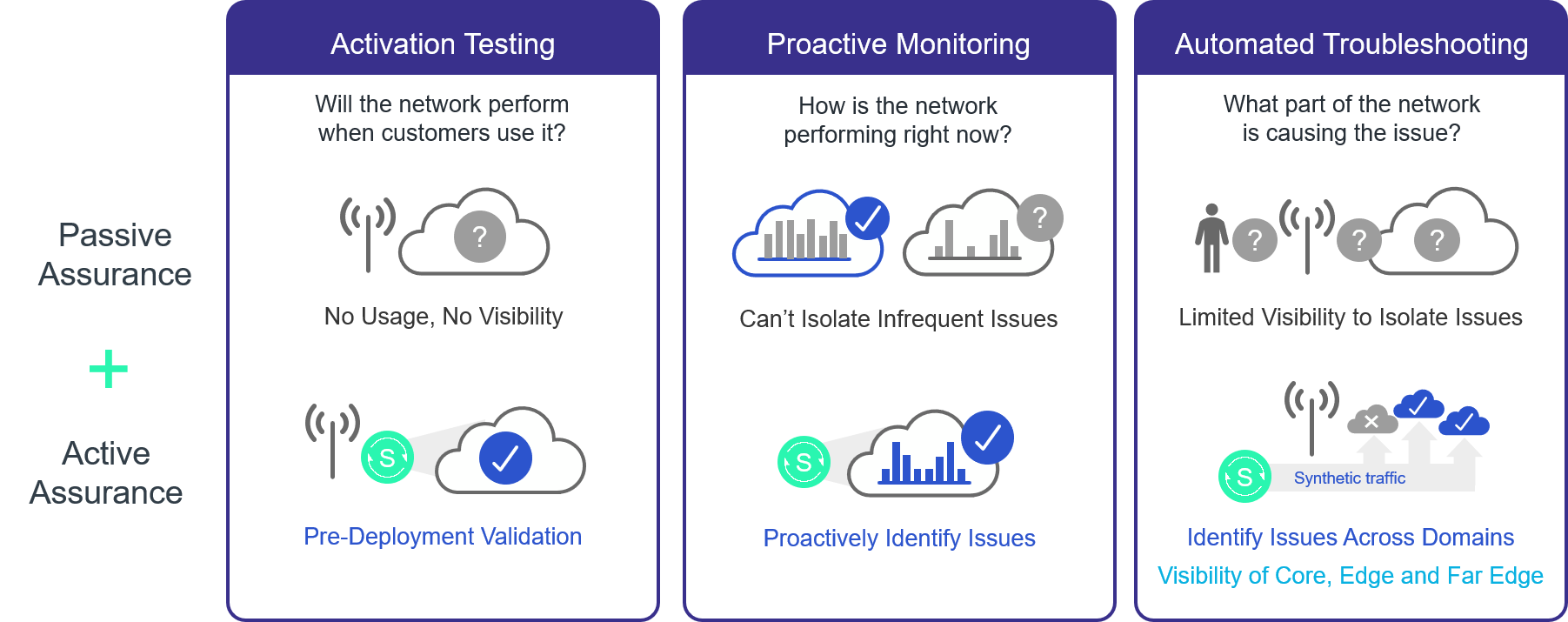When 4G networks were built, assurance strategies to protect performance were typically an afterthought. The consumer-focused nature of these networks meant operators could be more reactive in response to assurance needs. As problems emerged, they could surgically deploy a passive assurance solution where it was needed most, typically at mission-critical network locations, such as core network data centers.
This just isn’t practical with 5G. The market’s broader swath of customers will be far more discerning, with many demanding enterprise-level performance requirements. This includes new implementations such as network slicing, edge applications, Cellular Vehicle-to-Everything (C-V2X), augmented reality, emergency services – you name it. There will be a seemingly endless parade of high throughput, latency-sensitive applications, where even the slightest performance degradation could impact not just revenues, but public safety.
The complex architecture of 5G networks also creates more challenges in isolating issues. 5G brings disaggregation of the network, various types of edge distributions, a hybrid architecture for non-standalone (NSA) and new underlay requirements for standalone (SA). Seemingly overnight, this has all made the assurance discussion a more prevalent and urgent one, despite it still being early days for 5G networks.
It’s true that passive assurance has typically been a relatively expensive proposition when it comes to comprehensive coverage of the network. After all, it’s fraught with the physical considerations of processing massive amounts of data. But recent innovations that combine passive and active solutions are proving to be more cost-efficient and practical from a widespread rollout perspective. These developments are just in time for a global operator community increasingly recognizing that assurance is one aspect of network design that can no longer be put off for later.
Recent innovations that combine passive and active solutions are proving to be more cost-efficient and practical from a widespread rollout perspective.
The best time to start planning assurance strategies is now
Operators considering assurance options for 5G are primarily evaluating two options:
Passive assurance: Proven in 4G deployments globally, passive assurance has historically involved placing physical probes in line at critical network locations. They look at all traffic flowing through the network, monitoring for failures. Passive assurance is costly to deploy given the significant physical requirements at each site. As a result, it is typically reserved for the most critical and sensitive parts of the network.
Active assurance: Active assurance has traditionally been used in fixed networks but is becoming more prevalent in 5G networks given its lighter rollout requirements. In active assurance deployments, rather than process and analyze every bit of actual traffic, small amounts of synthetic traffic are generated continuously, or on-demand, on the network and used to uncover performance and security issues. This approach can expose network issues even when real traffic isn’t flowing and it’s far more cost-efficient to deploy given limited physical requirements. Active testing is the foundation for monitoring and validating service-level agreements (SLA) which is essential to monetize 5G applications.

In reality, passive and active assurance will be deployed in concert. For specific applications in certain network locations, passive assurance will continue to be a requirement. Active assurance technology, though, will make it possible to deploy assurance virtually anywhere, especially as more services and functions move to the cloud. As providers turn to edge clouds to offer differentiated, low-latency services, 5G networks are poised to add an unending number of edge endpoints over the next several years. Examples include automated validation and revalidation of network changes before and after activation, as well as, proactive performance, service quality and user experience monitoring.
This represents at least 4-5x as many locations as today’s networks. And that’s just to start. Far edge clouds will potentially bring another order of magnitude increase in endpoints. Consider the storage, processing and bandwidth costs associated with passively monitoring user traffic in all these locations. Whereas passive assurance would be prohibitively expensive, active assurance wins the moment with a significantly lighter load and minimal requirements, making ongoing costs more of a blip than a blimp. Facing this reality, active assurance represents a solid strategy for keeping costs under control while still meeting stringent performance requirements.
Though it is still the early days for 5G rollouts, Spirent has already been at work supporting the assurance strategies of leading operators that recognize the importance of ensuring new network services deliver as promised. From a practical perspective, active assurance is also emerging as a viable and cost-effective approach for addressing SLA requirements from enterprise customers – an area of growing importance for wireless operators.
With the potential for 5G to deliver life-changing and in some cases life-saving services, the old approach to assurance doesn’t align with the new architecture and the demands placed on this new technology. The industry recognizes it cannot afford any missteps as 5G core and 5G standalone rollouts gain steam. Active assurance should get serious consideration as a cost-effective, scalable, highly-effective means to ensures networks deliver in a big way once they are truly under the spotlight.
Dive deeper into your 5G active assurance strategy







